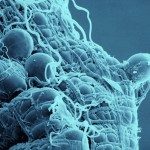Lien vers Pubmed [PMID] – 26406240
PLoS Negl Trop Dis 2015 Sep;9(9):e0004100
BACKGROUND: Dengue laboratory diagnosis is essentially based on detection of the virus, its components or antibodies directed against the virus in blood samples. Blood, however, may be difficult to draw in some patients, especially in children, and sampling during outbreak investigations or epidemiological studies may face logistical challenges or limited compliance to invasive procedures from subjects. The aim of this study was to assess the possibility of using saliva and urine samples instead of blood for dengue diagnosis.
METHODOLOGY/PRINCIPAL FINDINGS: Serial plasma, urine and saliva samples were collected at several time-points between the day of admission to hospital until three months after the onset of fever in children with confirmed dengue disease. Quantitative RT-PCR, NS1 antigen capture and ELISA serology for anti-DENV antibody (IgG, IgM and IgA) detection were performed in parallel on the three body fluids. RT-PCR and NS1 tests demonstrated an overall sensitivity of 85.4%/63.4%, 41.6%/14.5% and 39%/28.3%, in plasma, urine and saliva specimens, respectively. When urine and saliva samples were collected at the same time-points and tested concurrently, the diagnostic sensitivity of RNA and NS1 detection assays was 69.1% and 34.4%, respectively. IgG/IgA detection assays had an overall sensitivity of 54.4%/37.4%, 38.5%/26.8% and 52.9%/28.6% in plasma, urine and saliva specimens, respectively. IgM were detected in 38.1% and 36% of the plasma and saliva samples but never in urine.
CONCLUSIONS: Although the performances of the different diagnostic methods were not as good in saliva and urine as in plasma specimens, the results obtained by qRT-PCR and by anti-DENV antibody ELISA could well justify the use of these two body fluids to detect dengue infection in situations when the collection of blood specimens is not possible.

